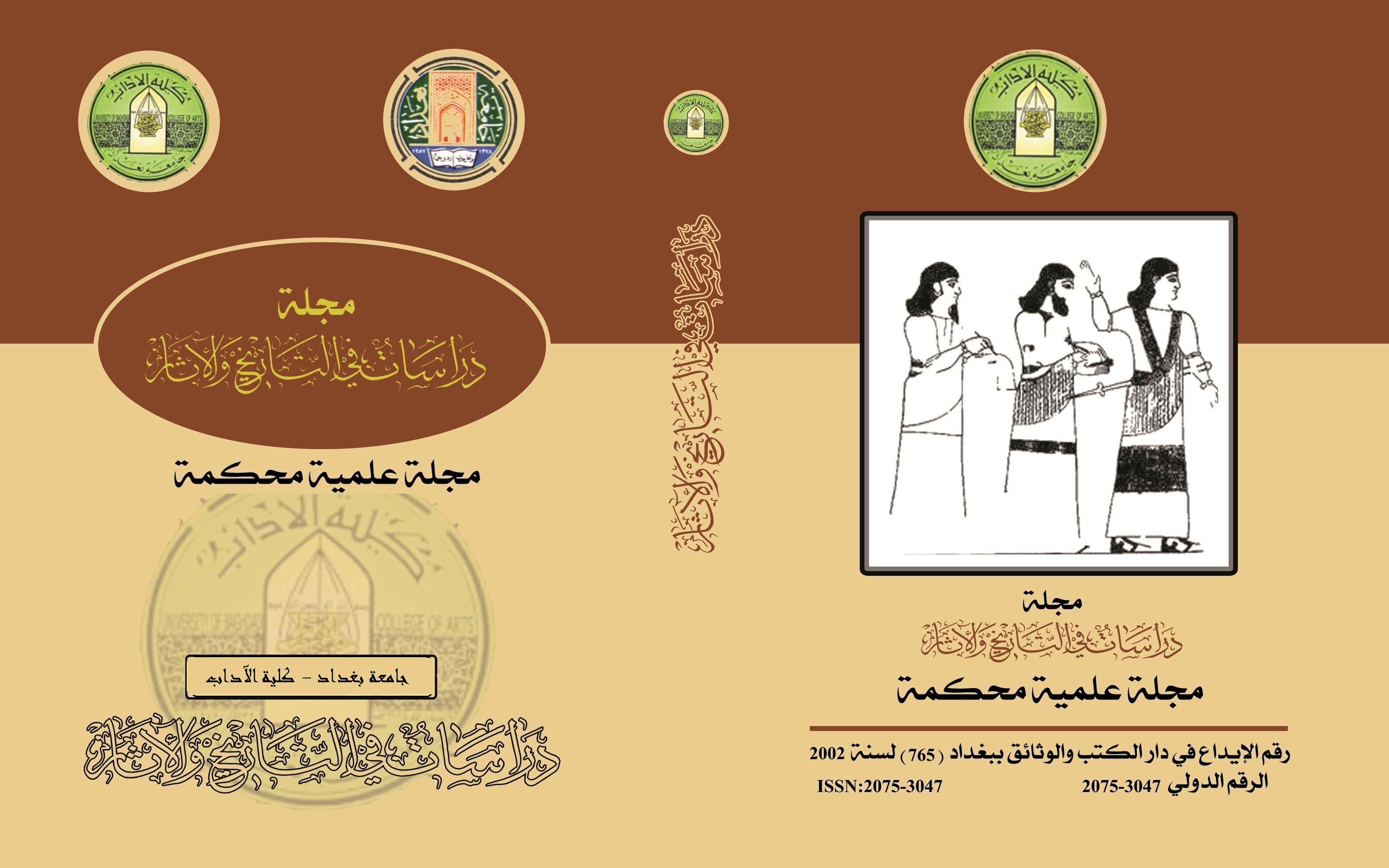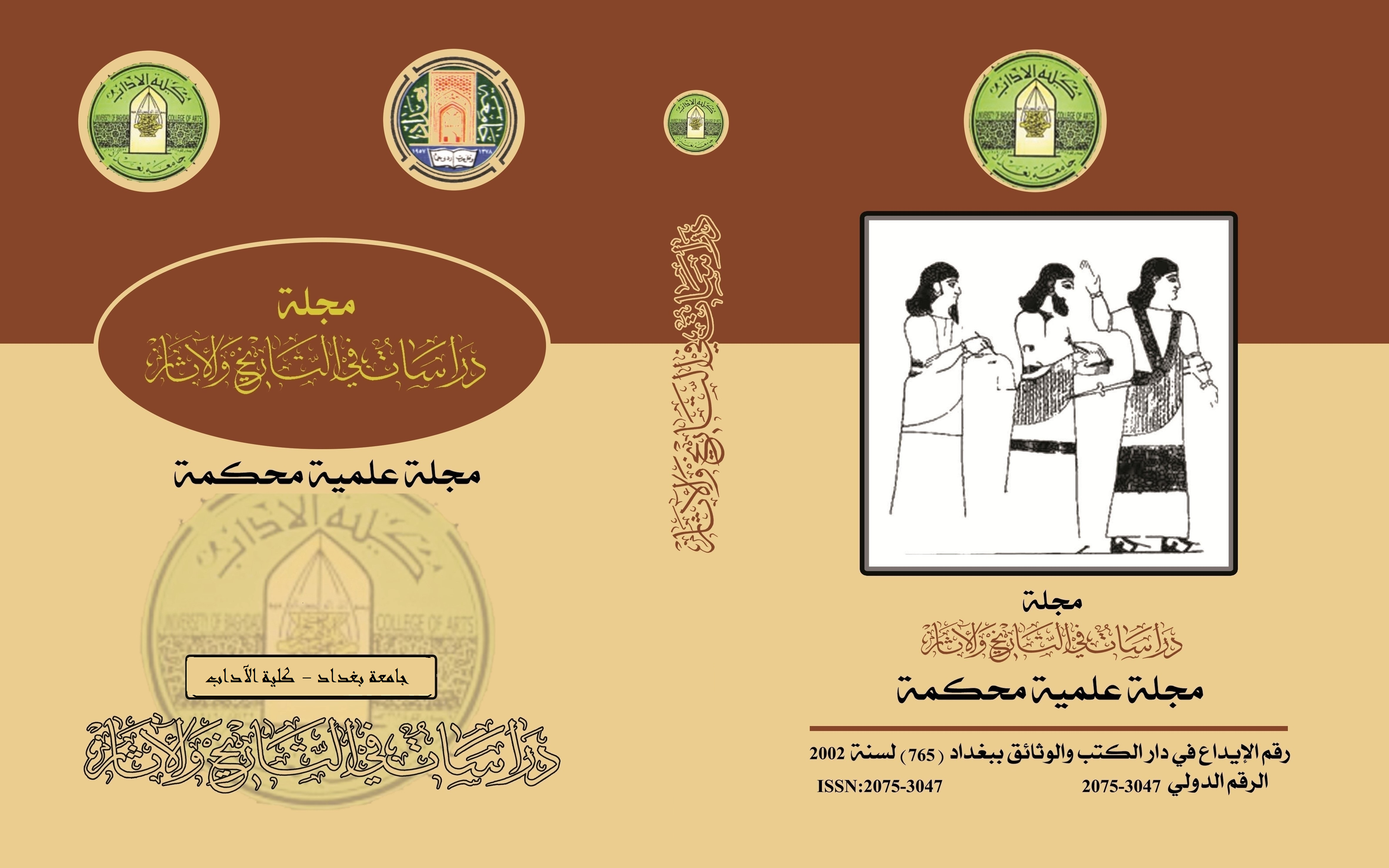الذهب في أدب بلاد الرافدين
الكلمات المفتاحية:
الذهب، الالهة، بلاد الرافدين، الادب، اسطورة، العالم الاسفلالملخص
عد الذهب من بين المعادن النفيسة في بلاد الرافدين ،واستعمل الذهب في مجالات وصناعات عدة في بلاد الرافدين ،وقد ورد ذكر الذهب في نصوص مسمارية عدة ومنها النصوص الادبية ،اذ ورد ذكره في الاساطير والملاحم وأدب المناظرات والمراثي ،وكذلك ورد ذكر الذهب في ادب الحكمة والرسائل ،وبينت النصوص الادبية اهمية الذهب في حضارة بلاد الرافدين واستعماله في جوانب مختلفة من حياة سكان بلاد الرافدين وبينت كذلك الاماكن التي جلب منها الذهب ،وبينت اهميته بالنسبة للإلهة من خلال ارتداءه مثل الحلي او من خلال صنع تماثيل للإلهة من الذهب كما بينته الاساطير ،وبينت النصوص كذلك استعمال الذهب في النصوص الادبية لوصف جمال شخص او وصف جمال شخصيته كما في احد الرسائل وصف شخص لصفاته امه اذا شبهه بالذهب، وكذلك شكل الذهب احد المحاور المهمة في بلاد الرافدين وذلك لصفاته المميز التي يحملها ومنها الديمومة ولونه البراق ألامع.
المراجع
اولاً:المصادر العربية
الاسود, حكمت بشير مجيد, ادب الرثاء في بلاد الرافدين في ضوء المصادر المسمارية, رسالة ماجستير غير منشورة, جامعة الموصل و كلية الآداب, قسم الآثار, 2002.
الاسود, حكمت بشير, ادب الغزل ومشاهد الآثارة في حضارة العراقية القديمة, ط 1, (سوريا, 2008).
احمد امين سليم, الأسرة في العراق القديم الدراسة عن طريق ادب الحكم والنصائح, (بيروت, 1985 ).
الحسيني, معدى الحسيني, أساطير العالم : أساطير السومرية, ط1, (القاهرة, 2012 ).
الجبوري, صلاح سلمان رميض, م: فاضل عبد الواحد علي, أدب الحكمة في وادي الرافدين, ( بغداد, 2000).
الجنابي, شيماء صلاح احمد, الإله أنكي في حضارة بلاد الرافدين في ضوء النصوص المسمارية, رسالة ماجستير غير منشورة, جامعة بغداد, كلية الآداب, قسم الآثار, 2007.
الدليمي, انس كريم عويز, الفضة في العصر الآشوري الحديث الكنوز الآشورية الفضي نموذجاً, رسالة ماجستير غير منشورة, جامعة بغداد, كلية الآداب, قسم الآثار, 2020.
السعدي, حسين عليوي عبد الحسين, الإله أنليل في بلاد الرافدين في ضوء النصوص المسمارية ,رسالة ماجستير غير منشورة ,جامعة بغداد ,كلية الاداب ,قسم الاثار , 2009.
الشواف ,قاسم ,”اناشيد الحب السومرية‟ ,ديوان الاساطير,الكتاب الاول ,(بيروت,1996).
الشواف, قاسم, ”الحضارة والسلطة‟, ديوان الأساطير, الكتاب الثالث, (بيروت, 1999).
الصفار, حسن مهدي, زراعة الشعير في العراق القديم من الألف الثالث ق . م حتى نهاية العصر البابلي القديم, رسالة ماجستير غير منشورة, جامعة بغداد, كلية الآداب, قسم الآثار, 2011.
الماجدي , خزعل, متون سومر, ط 1, (لبنان, 1998) .
دالي ,ستيفياني, أساطير من بلاد مابين النهرين, تر:نجوى نصر (نيويورك, 1991)
سهيل قاشا, الحكمة السومرية في العراق القديم, (بيروت, 2011 ).
صفوان سامي سعيد, ”مظاهر الحكمة وإبعادها في خطابات ملوك السلالة السرجونية‟, مجلة اثار الرافدين, ج 2, مج 7, جامعة الموصل, قسم الآثار, 2022.
طه باقر, مقدمة في تاريخ ادب العراق القديم , (بغداد, 1976 ).
طه باقر, ملحمة كلكامش, (بيروت, 2009).
فاضل عبد الواحد علي, الطوفان في المراجع المسمارية, (بغداد, 1975).
فاضل عبد الواحد, ”الادب‟, حضارة العراق, ج 2, (بغداد, 1985).
فاضل عبد الواحد علي, عشتار ومأساة تموز, (سوريا, 1999).
فؤاد جميل, الطوفان في المصادر السومرية –البابلية –الآشورية – العبرانية, (بيروت, 2014).
فؤاد سفر,”حفريات مديرية الاثار القديمة العامة في اريدو‟ ,سومر ,مج 3,ج 1,(بغداد ,1947).
فيروللو, شارل, أساطير بابل وكنعان, تر :ماجد خيربك, (بغداد, 1990 ).
كريمر, صموئيل نوح, الواح سومر, تر : طه باقر, م: احمد فخري, (بغداد, 1956 ).
كريمر, صموئيل نوح, السومريون تاريخهم وحضارتهم وخصائصهم, تر : الوائلي, فيصل, ط1, (لبنان, 2012 ).
لابات ,رينيه, المعتقدات الدينية في بلاد وادي الرافدين, تر : الاب البيرابونا وأخرون, ط 2, (بغداد, 2004).
نائل حنون, عقائد ما بعد الموت في حضارة بلاد وادي الرافدين القديمة, (بغداد, 1986).
نائل حنون, ملحمة كلكامش, ط1, (دمشق, 2006).
هروشكا ,بوهر سلاف ,وآخرون ,الاساطير في حضارة وادي الرافدين ,تر:عصام عبد اللطيف ,(بغداد,2006).
ثانياً: المصادر الاجنبية :
Civil, M, ‟The Message of Lu – Dingir –ra to His Mother and a Group of Akkadio-Hittite‟ Proverbs”, Jnes, vol.23, no .1,Chicago, 1964.
Leemans,W.F.,The Importance of Trade Some Introductory Remarks ,Vol.39,No.1,Jstor, 1977.
Rodin,Th.,The World of The Sumerian Mother Goddess An Interpretation,(Sweden,2014).
Said, A. S., Southern Mesopotamia in The Tim of Ashurbanipal, (Paris, 1968).
Vanstiphout, H., Epics of Sumerian Kings The Matter Of Aratta, (Atlanta, 2003).
منشور
إصدار
القسم
الرخصة

هذا العمل مرخص بموجب Creative Commons Attribution 4.0 International License.
:حقوق الطبع والنشر والترخيص
بالنسبة لجميع البحوث المنشورة في مجلة دراسات في التاريخ والآثار، يحتفظ الباحثون بحقوق النشر. يتم ترخيص البحوث بموجب ترخيص Creative Commons CC BY 4.0 المفتوح ، مما يعني أنه يجوز لأي شخص تنزيل البحث وقراءته مجانًا. بالإضافة إلى ذلك ، يجوز إعادة استخدام البحث واقتباسه شريطة أن يتم الاستشهاد المصدر المنشور الأصلي. تتيح هذه الشروط الاستخدام الأقصى لعمل الباحث وعرضه.
:إعادة إنتاج البحوث المنشورة من الناشرين الآخرين
من الضروري للغاية أن يحصل الباحثون على إذن لإعادة إنتاج أي بحث منشورة (أشكال أو مخططات أو جداول أو أي مقتطفات من نص) لا يدخل في نطاق الملكية العامة أو لا يملكون حقوق نشرها. يجب أن يطلب الباحثون إذنًا من مؤلف حقوق النشر (عادة ما يكون الناشر).
يطلب الإذن في الحالات التالية:
بحوثك الخاصة المنشورة من قِبل ناشرين آخرين ولم تحتفظ بحقوق النشر الخاصة بها.
مقتطفات كبيرة من بحوث أي شخص أو سلسلة من البحوث المنشورة.
استخدم الجداول والرسوم البيانية والمخططات والمخططات والأعمال الفنية إذا لم يتم التعديل عليها.
الصور الفوتوغرافية التي لا تملك حقوق لنشرها.
لا يطلب الإذن في الحالات التالية:
إعادة بناء الجدول الخاص بك مع البيانات المنشورة بالفعل في مكان آخر. يرجى ملاحظة أنه في هذه الحالة يجب عليك ذكر مصدر البيانات في شكل "بيانات من ..." أو "مقتبس من ...".
تعتبر عروض الأسعار القصيرة معقولة الاستخدام العادل ، وبالتالي لا تتطلب إذنًا.
الرسوم البيانية ، الرسوم البيانية ، المخططات ، الأعمال الفنية التي أعاد الباحث رسمها بالكامل والتي تم تغييرها بشكل ملحوظ إلى درجة لا تتطلب الاعتراف.
الحصول على إذن
لتجنب التأخير غير الضروري في عملية النشر ، يجب أن تبدأ في الحصول على أذونات في أقرب وقت ممكن. لا يمكن لمجلة الآداب نشر بحث مقتبس من منشورات أخرى دون إذن.
قد يمنحك مالك حقوق الطبع والنشر تعليمات بشأن شكل الإقرار الواجب اتباعه لتوثيق عمله ؛ بخلاف ذلك ، اتبع النمط: "مستنسخ بإذن من [المؤلف] ، [كتاب / المجلة] ؛ نشره [الناشر] ، [السنة]." في نهاية شرح الجدول ، الشكل أو المخطط.



















